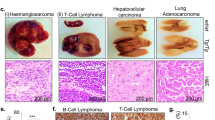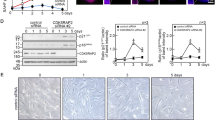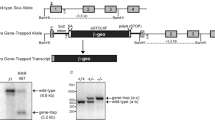Abstract
The mammalian NIMA-related kinases (Neks) are commonly referred to as mitotic kinases, although a definitive in vivo verification of this definition is largely missing. Reduction in the activity of Nek7 or its close paralog, Nek6, has previously been shown to arrest cells in mitosis, mainly at metaphase. In this study, we investigate the developmental and cellular roles of Nek7 kinase through the generation and analysis of Nek7-deficient mice. We show that absence of Nek7 leads to lethality in late embryogenesis or at early post-natal stages and to severe growth retardation. Mouse embryonic fibroblasts (MEFs) derived from Nek7−/− embryos show increase tendency for chromosomal lagging, micronuclei formation and cytokinesis failure. Tetraploidy and aneuploidy were commonly observed and their prevalence arises with MEFs passages. The frequency of multicentrosomal cells in the mutant's MEF cells was higher, and it commonly occurred concurrently with a binuclear phenotype, suggesting cytokinesis failure etiology. Lastly, the percentage of mutant MEF cells bearing primary cilia (PC) was low, whereas a cell population having two cilia appeared in the mutant MEFs. Taken together, these results confirm Nek7 as a regulator of cell division, and reveal it as an essential component for mammalian growth and survival. The intimate connection between tetraploidy, aneuploidy and cancer development suggests that Nek7 deregulation can induce oncogenesis.
This is a preview of subscription content, access via your institution
Access options
Subscribe to this journal
Receive 50 print issues and online access
$259.00 per year
only $5.18 per issue
Buy this article
- Purchase on Springer Link
- Instant access to full article PDF
Prices may be subject to local taxes which are calculated during checkout







Similar content being viewed by others
References
Akhter S, Richie CT, Deng JM, Brey E, Zhang X, Patrick Jr C et al. (2004). Deficiency in SNM1 abolishes an early mitotic checkpoint induced by spindle stress. Mol Cell Biol 24: 10448–10455.
Aleem E, Kaldis P . (2006). Mouse models of cell cycle regulators: new paradigms. Results Probl Cell Differ 42: 271–328.
Alieva IB, Vorobjev IA . (2004). Vertebrate primary cilia: a sensory part of centrosomal complex in tissue cells, but a ‘sleeping beauty’ in cultured cells? Cell Biol Int 28: 139–150.
Barr FA, Gruneberg U . (2007). Cytokinesis: placing and making the final cut. Cell 131: 847–860.
Belham C, Roig J, Caldwell JA, Aoyama Y, Kemp BE, Comb M et al. (2003). A mitotic cascade of NIMA family kinases. Nercc1/Nek9 activates the Nek6 and Nek7 kinases. J Biol Chem 278: 34897–34909.
Capra M, Nuciforo PG, Confalonieri S, Quarto M, Bianchi M, Nebuloni M et al. (2006). Frequent alterations in the expression of serine/threonine kinases in human cancers. Cancer Res 66: 8147–8154.
Castillo A, Morse III HC, Godfrey VL, Naeem R, Justice MJ . (2007). Overexpression of Eg5 causes genomic instability and tumor formation in mice. Cancer Res 67: 10138–10147.
De Souza CP, Horn KP, Masker K, Osmani SA . (2003). The SONB(NUP98) nucleoporin interacts with the NIMA kinase in Aspergillus nidulans. Genetics 165: 1071–1081.
Epstein CJ . (1967). Cell size, nuclear content, and the development of polyploidy in the mammalian liver. Proc Natl Acad Sci USA 57: 327–334.
Feige E, Motro B . (2002). The related murine kinases, Nek6 and Nek7, display distinct patterns of expression. Mech Dev 110: 219–223.
Fry AM, Nigg EA . (1995). Cell cycle. The NIMA kinase joins forces with Cdc2. Curr Biol 5: 1122–1125.
Fujiwara T, Bandi M, Nitta M, Ivanova EV, Bronson RT, Pellman D . (2005). Cytokinesis failure generating tetraploids promotes tumorigenesis in p53-null cells. Nature 437: 1043–1047.
Glotzer M . (2009). The 3Ms of central spindle assembly: microtubules, motors and MAPs. Nat Rev Mol Cell Biol 10: 9–20.
Habedanck R, Stierhof YD, Wilkinson CJ, Nigg EA . (2005). The Polo kinase Plk4 functions in centriole duplication. Nat Cell Biol 7: 1140–1146.
Kandli M, Feige E, Chen A, Kilfin G, Motro B . (2000). Isolation and characterization of two evolutionarily conserved murine kinases (Nek6 and nek7) related to the fungal mitotic regulator, NIMA. Genomics 68: 187–196.
Kim S, Lee K, Rhee K . (2007). NEK7 is a centrosomal kinase critical for microtubule nucleation. Biochem Biophys Res Commun 360: 56–62.
Kops GJ, Foltz DR, Cleveland DW . (2004). Lethality to human cancer cells through massive chromosome loss by inhibition of the mitotic checkpoint. Proc Natl Acad Sci USA 101: 8699–8704.
Lee MY, Kim HJ, Kim MA, Jee HJ, Kim AJ, Bae YS et al. (2008). Nek6 is involved in G2/M phase cell cycle arrest through DNA damage-induced phosphorylation. Cell Cycle 7: 2705–2709.
Liu S, Lu W, Obara T, Kuida S, Lehoczky J, Dewar K et al. (2002). A defect in a novel Nek-family kinase causes cystic kidney disease in the mouse and in zebrafish. Development 129: 5839–5846.
Mahjoub MR, Trapp ML, Quarmby LM . (2005). NIMA-related kinases defective in murine models of polycystic kidney diseases localize to primary cilia and centrosomes. J Am Soc Nephrol 16: 3485–3489.
Meraldi P, Honda R, Nigg EA . (2002). Aurora-A overexpression reveals tetraploidization as a major route to centrosome amplification in p53−/− cells. EMBO J 21: 483–492.
Meraldi P, Lukas J, Fry AM, Bartek J, Nigg EA . (1999). Centrosome duplication in mammalian somatic cells requires E2F and Cdk2–cyclin A. Nat Cell Biol 1: 88–93.
Michel LS, Liberal V, Chatterjee A, Kirchwegger R, Pasche B, Gerald W et al. (2001). MAD2 haplo-insufficiency causes premature anaphase and chromosome instability in mammalian cells. Nature 409: 355–359.
O'Connell MJ, Krien MJ, Hunter T . (2003). Never say never. The NIMA-related protein kinases in mitotic control. Trends Cell Biol 13: 221–228.
O'Regan L, Blot J, Fry AM . (2007). Mitotic regulation by NIMA-related kinases. Cell Div 2: 25.
O'Regan L, Fry AM . (2009). The Nek6 and Nek7 protein kinases are required for robust mitotic spindle formation and cytokinesis. Mol Cell Biol 29: 3975–3990.
Osmani AH, McGuire SL, Osmani SA . (1991). Parallel activation of the NIMA and p34cdc2 cell cycle-regulated protein kinases is required to initiate mitosis in A. nidulans. Cell 67: 283–291.
Parker JD, Bradley BA, Mooers AO, Quarmby LM . (2007). Phylogenetic analysis of the neks reveals early diversification of ciliary-cell cycle kinases. PLoS ONE 2: e1076.
Rapley J, Nicolas M, Groen A, Regue L, Bertran MT, Caelles C et al. (2008). The NIMA-family kinase Nek6 phosphorylates the kinesin Eg5 at a novel site necessary for mitotic spindle formation. J Cell Sci 121: 3912–3921.
Roig J, Groen A, Caldwell J, Avruch J . (2005). Active Nercc1 protein kinase concentrates at centrosomes early in mitosis and is necessary for proper spindle assembly. Mol Biol Cell 16: 4827–4840.
Roig J, Mikhailov A, Belham C, Avruch J . (2002). Nercc1, a mammalian NIMA-family kinase, binds the Ran GTPase and regulates mitotic progression. Genes Dev 16: 1640–1658.
Sage J, Miller AL, Perez-Mancera PA, Wysocki JM, Jacks T . (2003). Acute mutation of retinoblastoma gene function is sufficient for cell cycle re-entry. Nature 424: 223–228.
Scolnick DM, Halazonetis TD . (2000). Chfr defines a mitotic stress checkpoint that delays entry into metaphase. Nature 406: 430–435.
Shalom O, Shalva N, Altschuler Y, Motro B . (2008). The mammalian Nek1 kinase is involved in primary cilium formation. FEBS Lett 582: 1465–1470.
Shi Q, King RW . (2005). Chromosome nondisjunction yields tetraploid rather than aneuploid cells in human cell lines. Nature 437: 1038–1042.
Sjoblom T, Jones S, Wood LD, Parsons DW, Lin J, Barber TD et al. (2006). The consensus coding sequences of human breast and colorectal cancers. Science 314: 268–274.
Smith LA, Bukanov NO, Husson H, Russo RJ, Barry TC, Taylor AL et al. (2006). Development of polycystic kidney disease in juvenile cystic kidney mice: insights into pathogenesis, ciliary abnormalities, and common features with human disease. J Am Soc Nephrol 17: 2821–2831.
Storchova Z, Kuffer C . (2008). The consequences of tetraploidy and aneuploidy. J Cell Sci 121: 3859–3866.
Storchova Z, Pellman D . (2004). From polyploidy to aneuploidy, genome instability and cancer. Nat Rev Mol Cell Biol 5: 45–54.
Upadhya P, Birkenmeier EH, Birkenmeier CS, Barker JE . (2000). Mutations in a NIMA-related kinase gene, Nek1, cause pleiotropic effects including a progressive polycystic kidney disease in mice. Proc Natl Acad Sci USA 97: 217–221.
Walczak CE, Vernos I, Mitchison TJ, Karsenti E, Heald R . (1998). A model for the proposed roles of different microtubule-based motor proteins in establishing spindle bipolarity. Curr Biol 8: 903–913.
White MC, Quarmby LM . (2008). The NIMA-family kinase, Nek1 affects the stability of centrosomes and ciliogenesis. BMC Cell Biol 9: 29.
Wong C, Stearns T . (2005). Mammalian cells lack checkpoints for tetraploidy, aberrant centrosome number, and cytokinesis failure. BMC Cell Biol 6: 6.
Yin MJ, Shao L, Voehringer D, Smeal T, Jallal B . (2003). The serine/threonine kinase Nek6 is required for cell cycle progression through mitosis. J Biol Chem 278: 52454–52460.
Yissachar N, Salem H, Tennenbaum T, Motro B . (2006). Nek7 kinase is enriched at the centrosome, and is required for proper spindle assembly and mitotic progression. FEBS Lett 580: 6489–6495.
Acknowledgements
We thank G Damari and A Berkovitz from the Transgenic Unit of the Weizmann Institute for generation of chimeras. We also thank S Madar, Weizmann Institute, for real time RT–PCR analyses; R Palmiter, University of Washington, for providing the pNeoZTK2 vector. This study is supported by funds from Bar-Ilan Rector.
Author information
Authors and Affiliations
Corresponding author
Ethics declarations
Competing interests
The authors declare no conflict of interest.
Rights and permissions
About this article
Cite this article
Salem, H., Rachmin, I., Yissachar, N. et al. Nek7 kinase targeting leads to early mortality, cytokinesis disturbance and polyploidy. Oncogene 29, 4046–4057 (2010). https://doi.org/10.1038/onc.2010.162
Received:
Revised:
Accepted:
Published:
Issue Date:
DOI: https://doi.org/10.1038/onc.2010.162
Keywords
This article is cited by
-
NEK7: a new target for the treatment of multiple tumors and chronic inflammatory diseases
Inflammopharmacology (2022)
-
NEK7 promotes gastric cancer progression as a cell proliferation regulator
Cancer Cell International (2021)
-
NEK10 tyrosine phosphorylates p53 and controls its transcriptional activity
Oncogene (2020)
-
NEK7 regulates dendrite morphogenesis in neurons via Eg5-dependent microtubule stabilization
Nature Communications (2018)
-
Role of primary cilia in non-dividing and post-mitotic cells
Cell and Tissue Research (2017)



